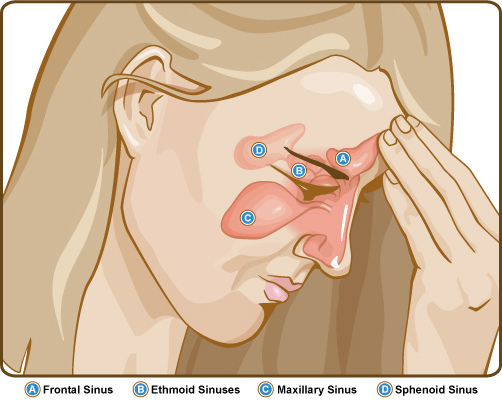Key Difference – Sinus Infection vs Upper Respiratory Tract Infection
The inflammation of the paranasal sinuses secondary to microbial infections is known as sinusitis. On the other hand, infection of the upper airway by different microbes is known as the upper respiratory tract infections. These two conditions often occur concomitantly. In sinus infections, any of the four groups of sinuses get infected, but in upper respiratory tract infections, it is the airway up to the trachea that gets infected. This is the key difference sinus infection and upper respiratory tract infection.
CONTENTS
1. Overview and Key Difference
2. What is Sinus Infection
3. What is Upper Respiratory Tract Infection
4. Similarities Between Sinus Infection and Upper Respiratory Tract Infection
5. Side by Side Comparison – Sinus Infection vs Upper Respiratory Tract Infection in Tabular Form
6. Summary
What is a Sinus Infection?
Sinusitis is the inflammation of the paranasal sinuses secondary to microbial infections. It is often associated with upper respiratory tract infections and asthma. Bacteria like Streptococcus pneumoniae and Hemophilus influenza are the commonest causative agents of sinusitis. Some fungi can also occasionally give rise to this condition.
Clinical Features
- Headaches
- Purulent rhinorrhea
- Facial pain with tenderness
- Fever
Trigeminal neuralgia, migraine, and cranial arteritis also have a similar clinical picture.

Figure 01: Sinuses
Sinusitis rarely occurs without a preceding episode of rhinitis. Because of this concurrence and the interrelationship between sinusitis and rhinitis, nowadays clinicians refer to sinusitis as rhinosinusitis.
Management
- Bacterial sinusitis can be treated with nasal decongestants and antibiotics such as co-amoxiclav. Anti-inflammatory drugs can be used to lessen the discomforts due to mucosal swellings.
- In case of recurrent sinusitis and any further complications, it is appropriate to take a CT scan.
- Functional Endoscopic Sinus Surgery is required in rare cases for the ventilation and drainage of the sinuses.
What is an Upper Respiratory Tract Infection?
Upper respiratory tract infections are one of the commonest groups of illnesses that we daily encounter in our life.
Infection of the upper airway by different microbes is defined as the upper respiratory tract infections
Symptoms and Signs of Upper Respiratory Tract Infections
- Nasal congestion
- Runny nose
- Sneezing
- Headache
- Myalgia
- Sometimes fever
- Reduced ability of smelling
These symptoms usually remain for about one week and gradually subside on their own. The failure of spontaneous resolution indicates the possibility of other diagnoses such as sinusitis.

Figure 02: Sneezing and a Runny Nose are Common Symptoms of an Upper Respiratory Tract Infection
Management
There is no use of giving antibiotics to upper respiratory tract infections because they are often caused by viruses. Therefore, there is no use of prescribing antibiotics when an upper respiratory tract infection is suspected. General measures such as massaging the frontal head with a warm towel, avoiding cold beverages and food and drinking hot drinks can provide relief from the symptoms. Using a handkerchief and covering the face while sneezing can help to prevent the spread of infection to others.
What are the Similarities Between Sinus Infection and Upper Respiratory Tract Infection?
- Both infections are caused microbes.
- Both conditions have some similar symptoms such as fever and headache.
What is the Difference Between Sinus Infection and Upper Respiratory Tract Infection?
Sinus Infection vs Upper Respiratory Tract Infection | |
| The inflammation of the paranasal sinuses secondary to microbial infections is known as sinusitis. | Infection of the upper airway by different microbes is defined as the upper respiratory tract infections. |
| Location | |
| Bacterial infections occur in the sinuses. | Upper respiratory tract infections occur in the airway up to the trachea. |
| Clinical Features | |
|
|
| Management | |
|
|
Summary – Sinus Infection vs Upper Respiratory Tract Infection
The inflammation of the paranasal sinuses secondary to microbial infections is known as sinusitis whereas upper respiratory tract infections are known as infections of the airway up to the trachea. Thus, the main difference between sinus infection and upper respiratory tract infection is that sinus infection affects the sinuses while upper respiratory tract infections affect the upper airway.
Reference:
1. Kumar, Parveen J., and Michael L. Clark. Kumar & Clark clinical medicine. Edinburgh: W.B. Saunders, 2009.
Image Courtesy
1. “Sinuses” (CC BY 2.0) via NIAID
2. “1079549” (CC0) via pxhere
ncG1vNJzZmivp6x7pbXFn5yrnZ6YsqOx07CcnqZemLyue8OinZ%2Bdopq7pLGMm5ytr5Wau26%2FyKesrGWZo7Omr9OipqdlkaOxbsLSZqypqJWnerOx0qmgq5mkpL%2B6edOrmJysXZ67p7HCraCopl8%3D